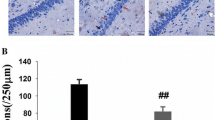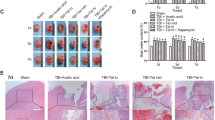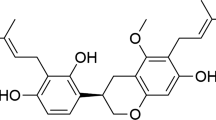Abstract
FTY720 is a synthetic compound produced by modification of metabolite from Isaria sinclairii. It is a novel type of immunosuppressive agent inhibiting lymphocyte egress from secondary lymphoid tissues, thereby causing peripheral lymphopenia. Growing evidences have suggested that apoptosis and autophagy were involved in the secondary brain injury after traumatic brain injury (TBI) although FTY720 exerted neuroprotective effects in a variety of neurological diseases except TBI. The present study was aimed to investigate the role of FTY720 in a mouse model of TBI. In experiment 1, ICR mice were divided into four groups: sham group, TBI group, TBI + vehicle group, and TBI + FTY720 group. And the injured cerebral cortex (including both contused and penumbra) was used for analysis. We found that FTY720 administration after TBI improved neurobehavioral function, alleviated brain edema, accompanied by modulation of apoptotic indicators such as Bcl-2, Bcl-xL, Bax, and cytochrome c. In experiment 2, ICR mice were also divided into four groups: sham group, TBI + vehicle group, TBI + FTY720 group, and TBI + FTY720 + inhibitors group. And the injured cerebral cortex (including both contused and penumbra) was used for analysis. We found that FTY720 increased the expression of phospho-protein kinase B (AKT) and some autophagy markers such as LC3 and Beclin 1. In addition, the apoptosis inhibition effect of FTY720 was partly abrogated by the phosphatidylinositide 3-kinases (PI3K)/AKT pathway inhibitor LY294002 and autophagy inhibitor 3-methyladenine. Collectively, our data provide the first evidence that FTY720 exerted neuroprotective effects after TBI, at least in part, through the activation of PI3K/AKT pathway and autophagy.





Similar content being viewed by others
References
Ang BT, Yap E, Lim J, Tan WL, Ng PY, Ng I, Yeo TT (2003) Poly(adenosine diphosphate-ribose) polymerase expression in human traumatic brain injury. J Neurosurg 99:125–130
Bao HJ, Wang T, Zhang MY, Liu R, Dai DK, Wang YQ, Wang L, Zhang L, Gao YZ, Qin ZH, Chen XP, Tao LY (2012) Poloxamer-188 attenuates TBI-induced blood-brain barrier damage leading to decreased brain edema and reduced cellular death. Neurochem Res 37:2856–2867
Campos F, Qin T, Castillo J, Seo JH, Arai K, Lo EH, Waeber C (2013) Fingolimod reduces hemorrhagic transformation associated with delayed tissue plasminogen activator treatment in a mouse thromboembolic model. Stroke 44:505–511
Chen SF, Tsai HJ, Hung TH, Chen CC, Lee CY, Wu CH, Wang PY, Liao NC (2012) Salidroside improves behavioral and histological outcomes and reduces apoptosis via PI3K/Akt signaling after experimental traumatic brain injury. PLoS One 7:e45763
Codogno P, Meijer AJ (2005) Autophagy and signaling: their role in cell survival and cell death. Cell Death Differ 12(Suppl 2):1509–1518
Cox-Limpens KE, Gavilanes AW, Zimmermann LJ, Vles JS (2014) Endogenous brain protection: what the cerebral transcriptome teaches us. Brain Res 1564C:85–100
Czech B, Pfeilschifter W, Mazaheri-Omrani N, Strobel MA, Kahles T, Neumann-Haefelin T, Rami A, Huwiler A, Pfeilschifter J (2009) The immunomodulatory sphingosine 1-phosphate analog FTY720 reduces lesion size and improves neurological outcome in a mouse model of cerebral ischemia. Biochem Biophys Res Commun 389:251–256
Dogan A, Rao AM, Baskaya MK, Rao VL, Rastl J, Donaldson D, Dempsey RJ (1997) Effects of ifenprodil, a polyamine site NMDA receptor antagonist, on reperfusion injury after transient focal cerebral ischemia. J Neurosurg 87:921–926
Endo H, Nito C, Kamada H, Yu F, Chan PH (2006) Akt/GSK3beta survival signaling is involved in acute brain injury after subarachnoid hemorrhage in rats. Stroke 37:2140–2146
Flierl MA, Stahel PF, Beauchamp KM, Morgan SJ, Smith WR, Shohami E (2009) Mouse closed head injury model induced by a weight-drop device. Nat Protoc 4:1328–1337
Hasegawa Y, Suzuki H, Sozen T, Rolland W, Zhang JH (2010) Activation of sphingosine 1-phosphate receptor-1 by FTY720 is neuroprotective after ischemic stroke in rats. Stroke 41:368–374
Hoane MR, Kaplan SA, Ellis AL (2006) The effects of nicotinamide on apoptosis and blood-brain barrier breakdown following traumatic brain injury. Brain Res 1125:185–193
Ishrat T, Sayeed I, Atif F, Hua F, Stein DG (2012) Progesterone is neuroprotective against ischemic brain injury through its effects on the phosphoinositide 3-kinase/protein kinase B signaling pathway. Neuroscience 210:442–450
Kitagishi Y, Matsuda S (2013) Diets involved in PPAR and PI3K/AKT/PTEN pathway may contribute to neuroprotection in a traumatic brain injury. Alzheimers Res Ther 5:42
Lin CJ, Chen TH, Yang LY, Shih CM (2014) Resveratrol protects astrocytes against traumatic brain injury through inhibiting apoptotic and autophagic cell death. Cell Death Dis 5:e1147
Lu L, Barfejani AH, Qin T, Dong Q, Ayata C, Waeber C (2014) Fingolimod exerts neuroprotective effects in a mouse model of intracerebral hemorrhage. Brain Res 1555:89–96
Luo CL, Li BX, Li QQ, Chen XP, Sun YX, Bao HJ, Dai DK, Shen YW, Xu HF, Ni H, Wan L, Qin ZH, Tao LY, Zhao ZQ (2011) Autophagy is involved in traumatic brain injury-induced cell death and contributes to functional outcome deficits in mice. Neuroscience 184:54–63
Luo CL, Li QQ, Chen XP, Zhang XM, Li LL, Li BX, Zhao ZQ, Tao LY (2013) Lipoxin A4 attenuates brain damage and downregulates the production of pro-inflammatory cytokines and phosphorylated mitogen-activated protein kinases in a mouse model of traumatic brain injury. Brain Res 1502:1–10
Maas AI, Stocchetti N, Bullock R (2008) Moderate and severe traumatic brain injury in adults. Lancet Neurol 7:728–741
Marmarou A (2007) A review of progress in understanding the pathophysiology and treatment of brain edema. Neurosurg Focus 22:E1
Naziroglu M, Senol N, Ghazizadeh V, Yuruker V (2014) Neuroprotection induced by N-acetylcysteine and selenium against traumatic brain injury-induced apoptosis and calcium entry in hippocampus of rat. Cell Mol Neurobiol 34:895–903
Noshita N, Lewen A, Sugawara T, Chan PH (2002) Akt phosphorylation and neuronal survival after traumatic brain injury in mice. Neurobiol Dis 9:294–304
Ovey IS, Naziroglu M (2015) Homocysteine and cytosolic GSH depletion induce apoptosis and oxidative toxicity through cytosolic calcium overload in the hippocampus of aged mice: involvement of TRPM2 and TRPV1 channels. Neuroscience 284:225–233
Paugh SW, Payne SG, Barbour SE, Milstien S, Spiegel S (2003) The immunosuppressant FTY720 is phosphorylated by sphingosine kinase type 2. FEBS Lett 554:189–193
Rink A, Fung KM, Trojanowski JQ, Lee VM, Neugebauer E, McIntosh TK (1995) Evidence of apoptotic cell death after experimental traumatic brain injury in the rat. Am J Pathol 147:1575–1583
Senol N, Naziroglu M, Yuruker V (2014) N-acetylcysteine and selenium modulate oxidative stress, antioxidant vitamin and cytokine values in traumatic brain injury-induced rats. Neurochem Res 39:685–692
Sun YX, Dai DK, Liu R, Wang T, Luo CL, Bao HJ, Yang R, Feng XY, Qin ZH, Chen XP, Tao LY (2013) Therapeutic effect of SN50, an inhibitor of nuclear factor-kappaB, in treatment of TBI in mice. Neurol Sci 34:345–355
Walker CL, Liu NK, Xu XM (2013) PTEN/PI3K and MAPK signaling in protection and pathology following CNS injuries. Front Biol (Beijing) 8:421–433
Wang YQ, Wang L, Zhang MY, Wang T, Bao HJ, Liu WL, Dai DK, Zhang L, Chang P, Dong WW, Chen XP, Tao LY (2012) Necrostatin-1 suppresses autophagy and apoptosis in mice traumatic brain injury model. Neurochem Res 37:1849–1858
Wang LT, Chen BL, Wu CT, Huang KH, Chiang CK, Hwa Liu S (2013) Protective role of AMP-activated protein kinase-evoked autophagy on an in vitro model of ischemia/reperfusion-induced renal tubular cell injury. PLoS One 8:e79814
Wang JW, Wang HD, Cong ZX, Zhou XM, Xu JG, Jia Y, Ding Y (2014) Puerarin ameliorates oxidative stress in a rodent model of traumatic brain injury. J Surg Res 186:328–337
Wei Y, Yemisci M, Kim HH, Yung LM, Shin HK, Hwang SK, Guo S, Qin T, Alsharif N, Brinkmann V, Liao JK, Lo EH, Waeber C (2011) Fingolimod provides long-term protection in rodent models of cerebral ischemia. Ann Neurol 69:119–129
Wirawan E, Vanden Berghe T, Lippens S, Agostinis P, Vandenabeele P (2012) Autophagy: for better or for worse. Cell Res 22:43–61
Xu J, Wang H, Ding K, Zhang L, Wang C, Li T, Wei W, Lu X (2014) Luteolin provides neuroprotection in models of traumatic brain injury via the Nrf2-ARE pathway. Free Radic Biol Med 71:186–195
Yap TA, Garrett MD, Walton MI, Raynaud F, de Bono JS, Workman P (2008) Targeting the PI3K-AKT-mTOR pathway: progress, pitfalls, and promises. Curr Opin Pharmacol 8:393–412
Yeh EA, Weinstock-Guttman B (2011) Fingolimod: an oral disease-modifying therapy for relapsing multiple sclerosis. Adv Ther 28:270–278
Yuruker V, Naziroglu M, Senol N (2015) Reduction in traumatic brain injury-induced oxidative stress, apoptosis, and calcium entry in rat hippocampus by melatonin: possible involvement of TRPM2 channels. Metab Brain Dis 30:223–231
Zhang X, Chen Y, Jenkins LW, Kochanek PM, Clark RS (2005) Bench-to-bedside review: apoptosis/programmed cell death triggered by traumatic brain injury. Crit Care 9:66–75
Zhang YB, Li SX, Chen XP, Yang L, Zhang YG, Liu R, Tao LY (2008) Autophagy is activated and might protect neurons from degeneration after traumatic brain injury. Neurosci Bull 24:143–149
Zhang HL, Xu M, Wei C, Qin AP, Liu CF, Hong LZ, Zhao XY, Liu J, Qin ZH (2011) Neuroprotective effects of pioglitazone in a rat model of permanent focal cerebral ischemia are associated with peroxisome proliferator-activated receptor gamma-mediated suppression of nuclear factor-kappaB signaling pathway. Neuroscience 176:381–395
Zhang L, Wang HD, Ji XJ, Cong ZX, Zhu JH, Zhou Y (2013) FTY720 for cancer therapy (Review). Oncol Rep 30:2571–2578
Acknowledgments
This work was supported by grants from the National Natural Science Foundation of China (Nos. 81371357 & 81401026) and the China Postdoctoral Science Foundation funded project under Grant (No. 2014M562665).
Conflict of interest
The authors declare no potential conflicts of interest.
Author information
Authors and Affiliations
Corresponding author
Additional information
Li Zhang and Ke Ding equally contributed to this work.
Rights and permissions
About this article
Cite this article
Zhang, L., Ding, K., Wang, H. et al. Traumatic Brain Injury-Induced Neuronal Apoptosis is Reduced Through Modulation of PI3K and Autophagy Pathways in Mouse by FTY720. Cell Mol Neurobiol 36, 131–142 (2016). https://doi.org/10.1007/s10571-015-0227-1
Received:
Accepted:
Published:
Issue Date:
DOI: https://doi.org/10.1007/s10571-015-0227-1




